2014 Peugeot Boxer park assist
[x] Cancel search: park assistPage 4 of 240
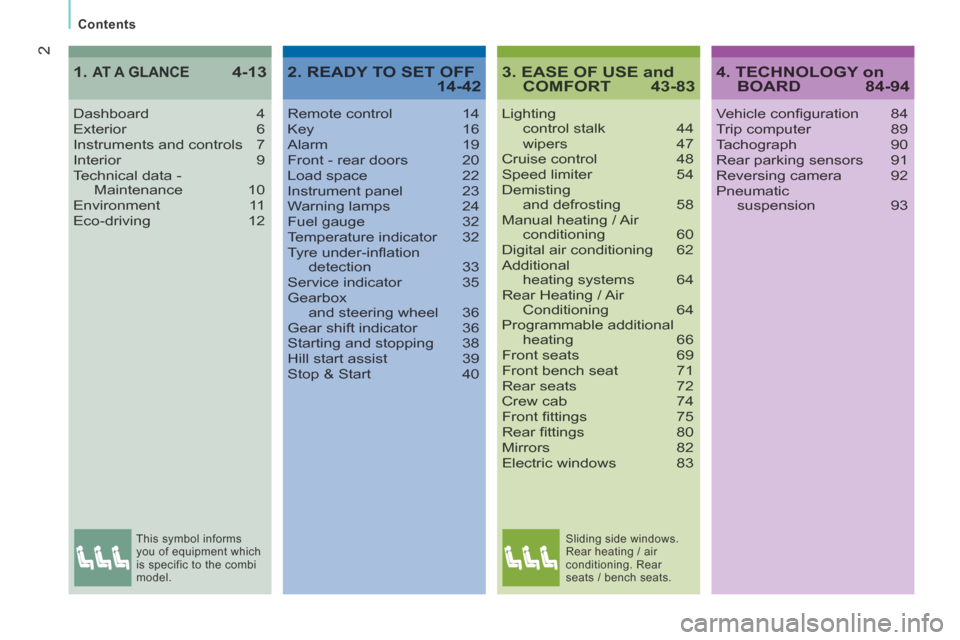
2
Contents
3. EASE OF USE and COMFORT 43-83
Lighting control stalk 44 wipers 47Cruise control 48Speed limiter 54Demisting and defrosting 58Manual heating / Air conditioning 60Digital air conditioning 62Additional heating systems 64Rear Heating / Air Conditioning 64Programmable additional heating 66Front seats 69Front bench seat 71Rear seats 72Crew cab 74Front fi ttings 75Rear fi ttings 80Mirrors 82Electric windows 83
Dashboard 4Exterior 6Instruments and controls 7Interior 9Technical data - Maintenance 10Environment 11Eco-driving 12
1. AT A GLANCE 4-134. TECHNOLOGY on BOARD 84-94
Vehicle confi guration 84Trip computer 89Tachograph 90Rear parking sensors 91Reversing camera 92Pneumatic suspension 93
2. READY TO SET OFF 14-42
Remote control 14Key 16Alarm 19Front - rear doors 20Load space 22Instrument panel 23Warning lamps 24Fuel gauge 32Temperature indicator 32Tyre under-infl ation detection 33Service indicator 35Gearbox and steering wheel 36Gear shift indicator 36Starting and stopping 38Hill start assist 39Stop & Start 40
This symbol informs
you of equipment which
is specific to the combi
model. Sliding side windows.
Rear heating / air
conditioning. Rear
seats / bench seats.
Page 5 of 240
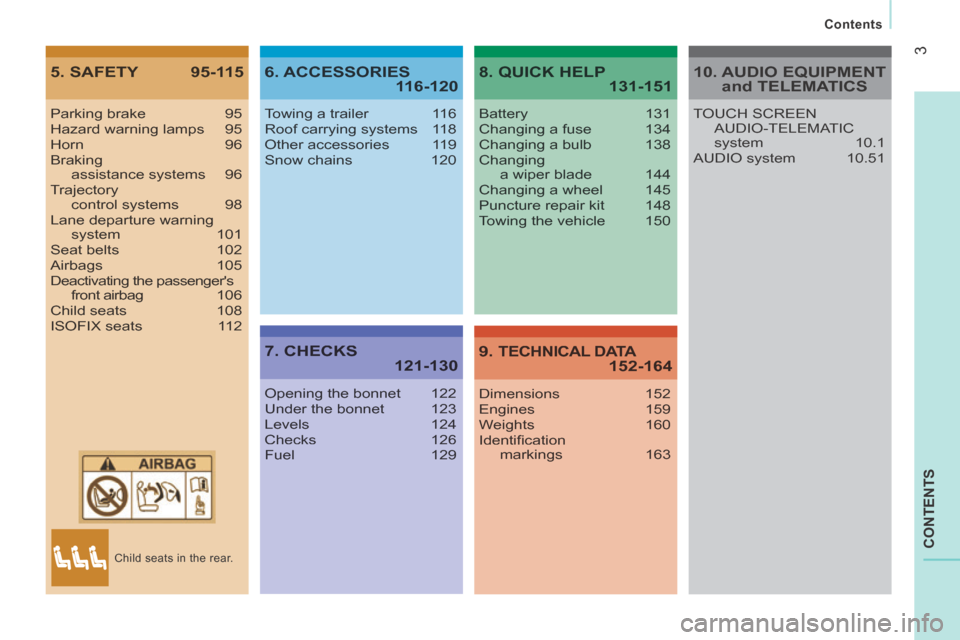
3
Contents
CONTENTS
5. SAFETY 95-1156. ACCESSORIES 116-120
7. CHECKS 121-130
8. QUICK HELP 131-151
9. TECHNICAL DATA 152-164
Parking brake 95Hazard warning lamps 95Horn 96Braking assistance systems 96Trajectory control systems 98Lane departure warning system 101Seat belts 102Airbags 105Deactivating the passenger's front airbag 106Child seats 108ISOFIX seats 112
Towing a trailer 116Roof carrying systems 118Other accessories 119Snow chains 120
Opening the bonnet 122Under the bonnet 123Levels 124Checks 126Fuel 129
Battery 131Changing a fuse 134Changing a bulb 138Changing a wiper blade 144Changing a wheel 145Puncture repair kit 148Towing the vehicle 150
Dimensions 152Engines 159Weights 160Identifi cation markings 163
10. AUDIO EQUIPMENT and TELEMATICS
TOUCH SCREEN AUDIO-TELEMATIC system 10.1AUDIO system 10.51
Child seats in the rear.
Page 8 of 240
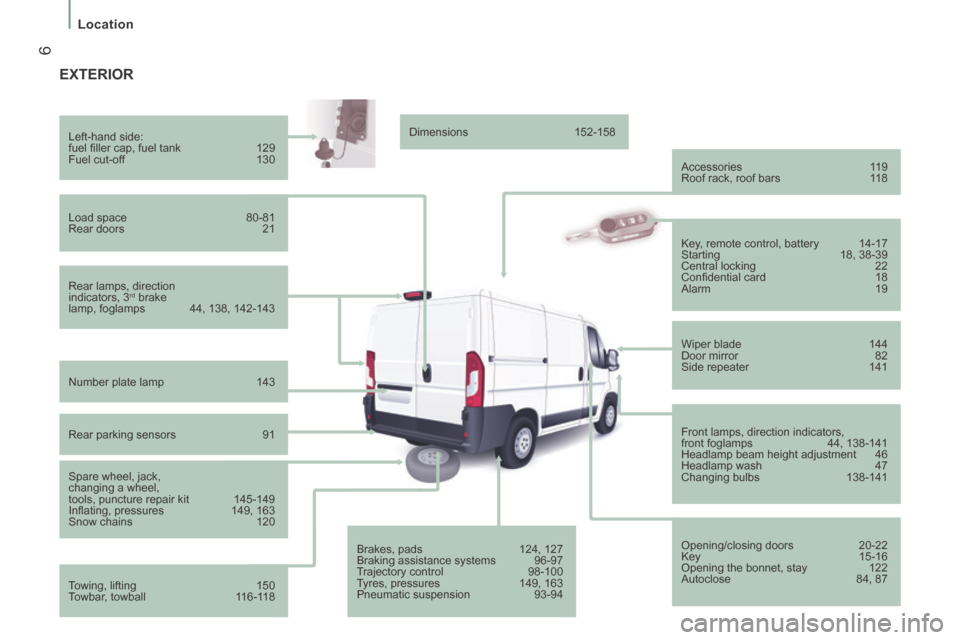
6
Location
EXTERIOR
Rear lamps, direction
indicators, 3 rd brake
lamp, foglamps 44, 138, 142-143 Left-hand side:
fuel fi ller cap, fuel tank 129
Fuel cut-off 130
Load space 80-81
Rear doors 21
Number plate lamp 143
Rear parking sensors 91
Spare wheel, jack,
changing a wheel,
tools, puncture repair kit 145-149
Infl ating, pressures 149, 163
Snow chains 120
Towing, lifting 150
Towbar, towball 116-118 Dimensions
152-158
Accessories 119
Roof rack, roof bars 118
Brakes, pads 124, 127
Braking assistance systems 96-97
Trajectory control 98-100
Tyres, pressures 149, 163
Pneumatic suspension 93-94 Key, remote control, battery 14-17
Starting
18, 38-39
Central locking 22
Confi dential card 18
Alarm 19
Wiper blade 144
Door mirror 82
Side repeater 141
Front lamps, direction indicators,
front foglamps 44, 138-141
Headlamp beam height adjustment 46
Headlamp wash 47
Changing bulbs 138-141
Opening/closing doors 20-22
Key 15-16
Opening the bonnet, stay 122
Autoclose 84, 87
Page 26 of 240
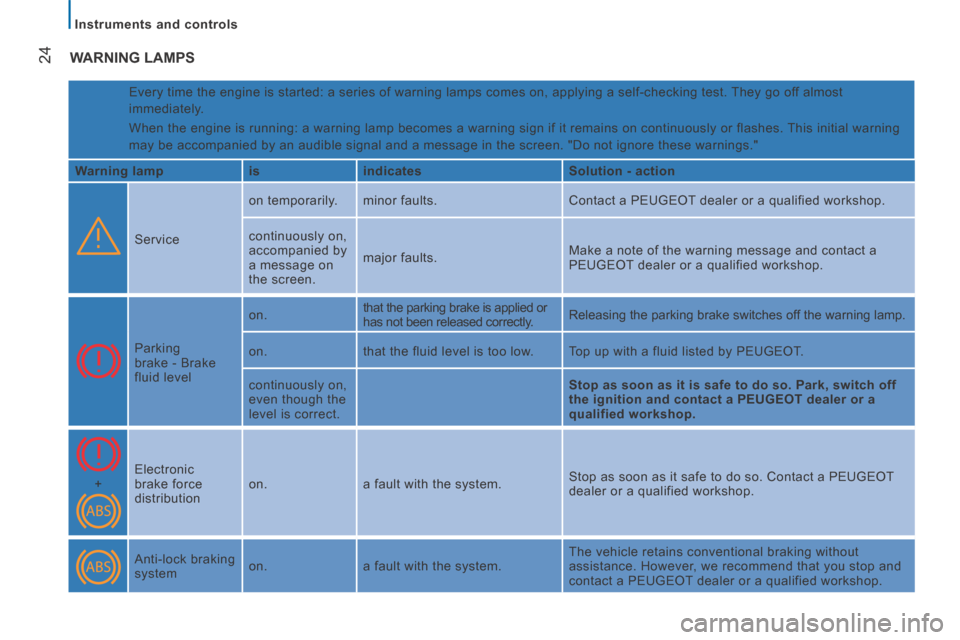
24
Instruments and controls
WARNING LAMPS
Every time the engine is started: a series of warning lamps comes on, ap\
plying a self-checking test. They go off almost
immediately.
When the engine is running: a warning lamp becomes a warning sign if it \
remains on continuously or flashes. This initial warning
may be accompanied by an audible signal and a message in the screen. "Do\
not ignore these warnings."
Warning lamp is indicates Solution - action
Service on temporarily.
minor faults. Contact a PEUGEOT dealer or a qualified workshop.
continuously on,
accompanied by
a message on
the screen. major faults.
Make a note of the warning message and contact a
PEUGEOT dealer or a qualified workshop.
Parking
brake - Brake
fluid level on.
that the parking brake is applied or
has not been released correctly. Releasing the parking brake switches off the warning lamp.
on. that the fluid level is too low. Top up with a fluid listed by PEUGEOT.
continuously on,
even though the
level is correct. Stop as soon as it is safe to do so. Park, switch off
the ignition and contact a PEUGEOT dealer or a
qualified workshop.
+ Electronic
brake force
distribution on.
a fault with the system. Stop as soon as it safe to do so. Contact a PEUGEOT
dealer or a qualified workshop.
Anti-lock braking
system on.
a fault with the system. The vehicle retains conventional braking without
assistance. However, we recommend that you stop and
contact a PEUGEOT dealer or a qualified workshop.
Page 29 of 240
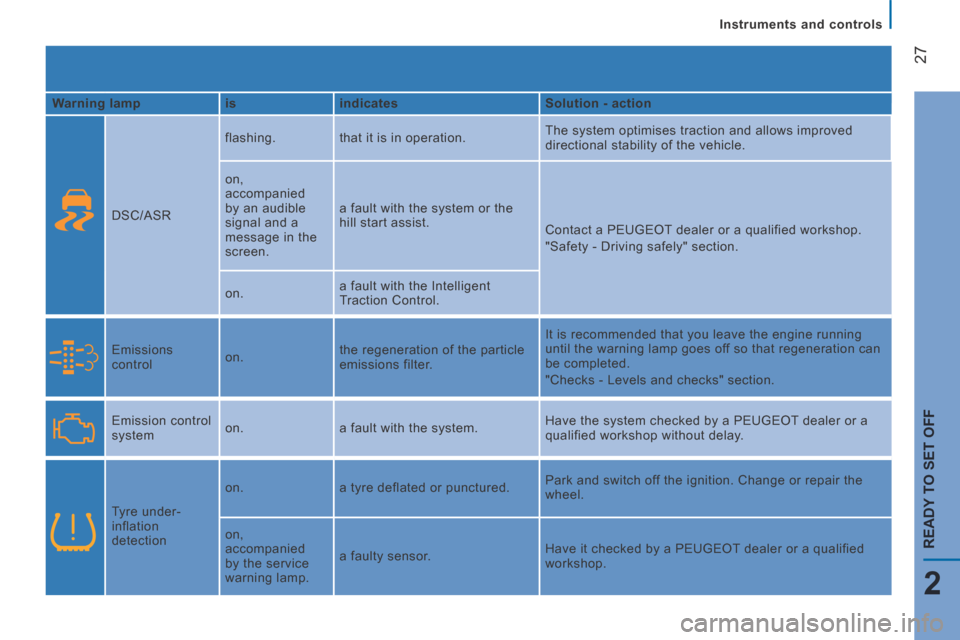
27
2
READY TO SET OFF
Instruments and controls
Warning lamp is indicates Solution - action
DSC/ASR flashing.
that it is in operation. The system optimises traction and allows improved
directional stability of the vehicle.
on,
accompanied
by an audible
signal and a
message in the
screen. a fault with the system or the
hill start assist.
Contact a PEUGEOT dealer or a qualified workshop.
"Safety - Driving safely" section.
on. a fault with the Intelligent
Traction Control.
Emissions
control on. the regeneration of the particle
emissions filter. It is recommended that you leave the engine running
until the warning lamp goes off so that regeneration can
be completed.
"Checks - Levels and checks" section.
Emission control
system on.
a fault with the system. Have the system checked by a PEUGEOT dealer or a
qualified workshop without delay.
Tyre under-
inflation
detection on.
a tyre deflated or punctured. Park and switch off the ignition. Change or repair the
wheel.
on,
accompanied
by the service
warning lamp. a faulty sensor.
Have it checked by a PEUGEOT dealer or a qualified
workshop.
Page 41 of 240
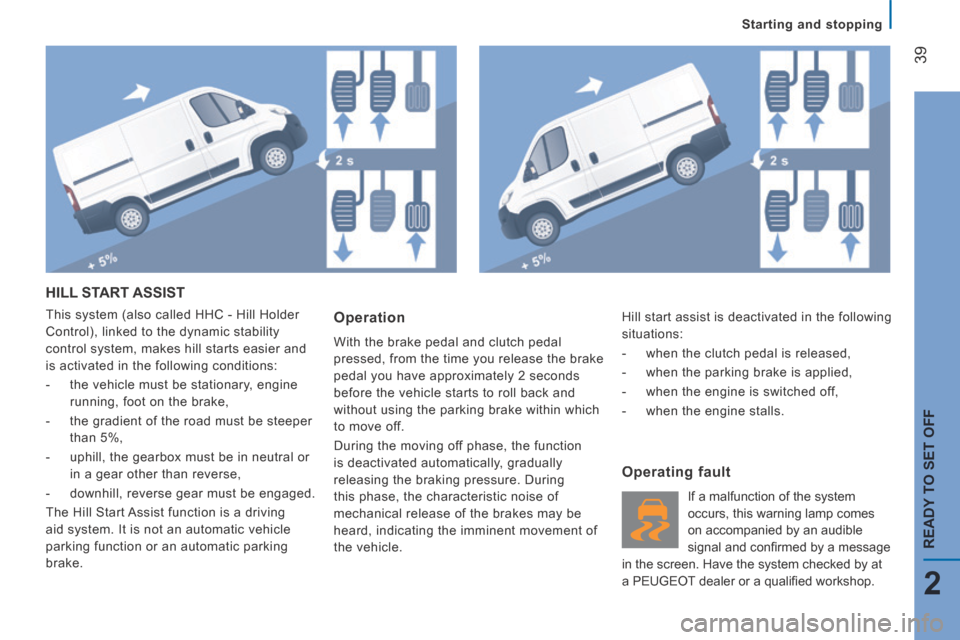
39
2
READY TO SET OFF
Starting and stopping
HILL START ASSIST
This system (also called HHC - Hill Holder
Control), linked to the dynamic stability
control system, makes hill starts easier and
is activated in the following conditions:
- the vehicle must be stationary, engine running, foot on the brake,
- the gradient of the road must be steeper than 5%,
- uphill, the gearbox must be in neutral or in a gear other than reverse,
- downhill, reverse gear must be engaged.
The Hill Start Assist function is a driving
aid system. It is not an automatic vehicle
parking function or an automatic parking
brake. Operation
With the brake pedal and clutch pedal
pressed, from the time you release the brake
pedal you have approximately 2 seconds
before the vehicle starts to roll back and
without using the parking brake within which
to move off.
During the moving off phase, the function
is deactivated automatically, gradually
releasing the braking pressure. During
this phase, the characteristic noise of
mechanical release of the brakes may be
heard, indicating the imminent movement of
the vehicle.
Operating fault
If a malfunction of the system
occurs, this warning lamp comes
on accompanied by an audible
signal and confi rmed by a message
in the screen. Have the system checked by at
a PEUGEOT dealer or a qualifi ed workshop. Hill start assist is deactivated in the following
situations:
- when the clutch pedal is released,
- when the parking brake is applied,
- when the engine is switched off,
- when the engine stalls.
Page 42 of 240
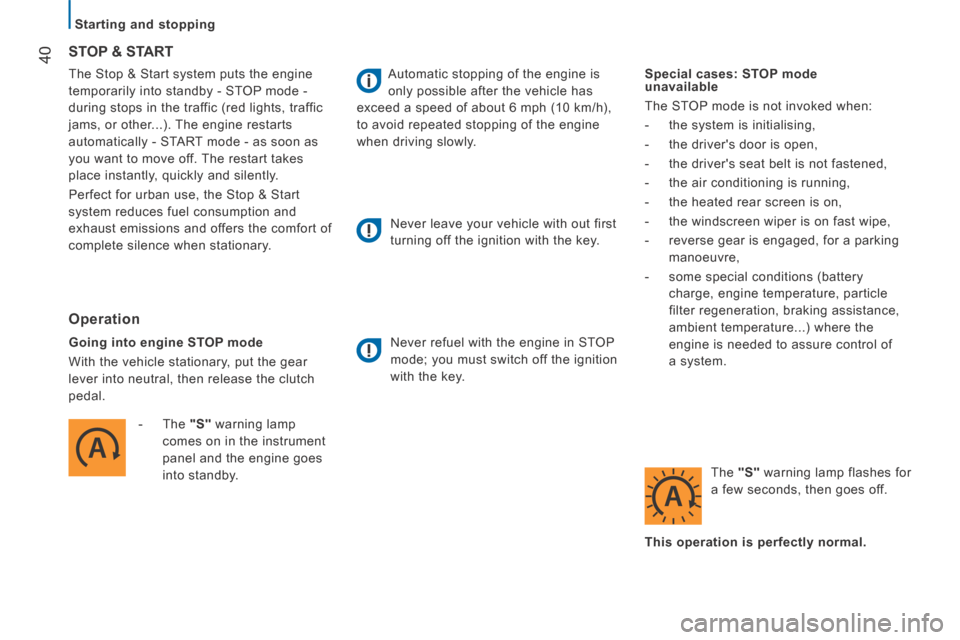
40
Starting and stopping
The Stop & Start system puts the engine
temporarily into standby - STOP mode -
during stops in the traffic (red lights, traffic
jams, or other...). The engine restarts
automatically - START mode - as soon as
you want to move off. The restart takes
place instantly, quickly and silently.
Perfect for urban use, the Stop & Start
system reduces fuel consumption and
exhaust emissions and offers the comfort of
complete silence when stationary.
STOP & START
Operation
Going into engine STOP mode
With the vehicle stationary, put the gear
lever into neutral, then release the clutch
pedal. - The "S" warning lamp comes on in the instrument
panel and the engine goes
into standby. Automatic stopping of the engine is
only possible after the vehicle has
exceed a speed of about 6 mph (10 km/h),
to avoid repeated stopping of the engine
when driving slowly.
Never leave your vehicle with out first
turning off the ignition with the key.
Never refuel with the engine in STOP
mode; you must switch off the ignition
with the key. Special cases: STOP mode
unavailable
The STOP mode is not invoked when:
- the system is initialising,
- the driver's door is open,
- the driver's seat belt is not fastened,
- the air conditioning is running,
- the heated rear screen is on,
- the windscreen wiper is on fast wipe,
- reverse gear is engaged, for a parking
manoeuvre,
- some special conditions (battery charge, engine temperature, particle
filter regeneration, braking assistance,
ambient temperature...) where the
engine is needed to assure control of
a system.
The "S" warning lamp flashes for
a few seconds, then goes off.
This operation is perfectly normal.
Page 152 of 240
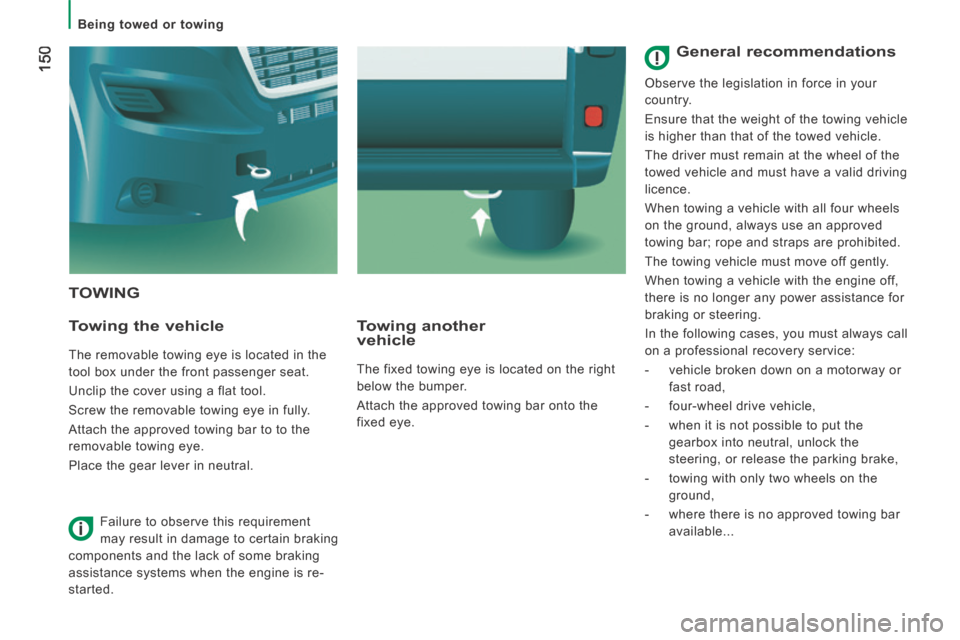
150
Being towed or towing
TOWING
Towing the vehicle
The removable towing eye is located in the
tool box under the front passenger seat.
Unclip the cover using a flat tool.
Screw the removable towing eye in fully.
Attach the approved towing bar to to the
removable towing eye.
Place the gear lever in neutral.
Towing another vehicle
The fixed towing eye is located on the right
below the bumper.
Attach the approved towing bar onto the
fixed eye.
Failure to observe this requirement
may result in damage to certain braking
components and the lack of some braking
assistance systems when the engine is re-
started.
General recommendations
Observe the legislation in force in your
country.
Ensure that the weight of the towing vehicle
is higher than that of the towed vehicle.
The driver must remain at the wheel of the
towed vehicle and must have a valid driving
licence.
When towing a vehicle with all four wheels
on the ground, always use an approved
towing bar; rope and straps are prohibited.
The towing vehicle must move off gently.
When towing a vehicle with the engine off,
there is no longer any power assistance for
braking or steering.
In the following cases, you must always call
on a professional recovery service:
- vehicle broken down on a motorway or fast road,
- four-wheel drive vehicle,
- when it is not possible to put the gearbox into neutral, unlock the
steering, or release the parking brake,
- towing with only two wheels on the ground,
- where there is no approved towing bar available...